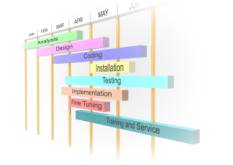|
 Outsourcing:
The Benefits and Sacrifices
Outsourcing:
The Benefits and Sacrifices
By
Richard Latty
Solutions
Engineering Corporation
7830
Old Georgetown Road
Bethesda,
Maryland 20814
Outsourcing is the strategic approach
to providing a capability to your organization
by having it provided by another organization
- one that specializes in that specific area.
This approach applies to many different
capabilities and services. This paper focuses on computer software and
provides a summary of the benefits and sacrifices,
which accrue to an organization by adopting this
approach. Outsourcing
software is not a good strategy for every organization. But where it fits, it is an exceptionally good
business strategy.
There are at least two ways to view the
issue - one from the viewpoint of a software engineer,
the other from the viewpoint of management of
a company with information system requirements.
We will look at both
The
benefits of outsourcing to the client include
benefits enjoyed due to aspects of the software
engineering company and due to the client not
having programming and development staff in-house.
Benefits
from properties of the outsource software engineering
firm:
- Depth
of Team - professional Design, Programming,
Quality Assurance & Testing, Documentation,
Training, Maintenance & Support,
- Collective
experience of the team,
- Structured
approach and its cost effectiveness,
- Efficiencies
enjoyed through re-engineering previously written
code,
- Knowledge
of end product capabilities from the beginning,
- Knowledge
of timeliness throughout by milestone definition,
- Tools
available - Design, Development, Documentation,
Training, Maintenance, Protection,
- Most
cost effective use of costly talent,
- Definable
costs for product enhancements,
- Implementation
tools selected to fit the needs of the project,
not programmer skills,
- Training
and Help Desk services
Benefits
from avoiding in-house programming staff:
- Reduced
payroll and fixed expenses,
- Freed
Hostage - No dependence on employee continuity
for software support and maintenance,
- Only
scheduled, tested, and approved releases to
the user community,
- Overall
reduced costs, and no ongoing costs associated
with use of the software,
- Ability
to evaluate cost/benefit of any proposed enhancements,
- Decisions
made in the best interests of the users and
core business of the company - not curtailed
by programmer issues or sensitivities,
- Reduced
time of staff consumed in design, development,
testing, training, and documentation,
- Reduced
time required to deliver product.
A
more detailed discussion of each of these follows.
II. BENEFITS FROM UTILIZING A SOFTWARE ENGINEERING FIRM
Depth of Team. Outsourcing will give the company a depth of
team members that are rarely provided by a typical
in-house staff. To build sound, versatile, and comprehensive
software, design databases which accommodate near
and long term needs, you need capable, experienced,
and focused talent.
High quality information systems are not
just written. Each step in a series must be completed correctly
in order to provide a high quality, relevant,
and durable IS (information system).
This is accomplished by an IS team.
Management and operations staff must be
queried to obtain the full set of requirements,
priorities, constraints, views of the future,
and inputs relevant to the design of the IS.
A design team compiles these into a Design
Definition document and iterate  with
management and operations staff in defining the
target IS (or the blue print of the IS) to be
constructed. The software development team builds the IS
to the specification.
Every hour spent in the design definition
will save many hours in the software development
effort. Additionally,
it will save hundreds of hours in time required
to support the IS later on. Not only will a well designed IS require less
code to implement, it will be more modular, it
will have common functionality achieved by the
same code bodies, and it will be buildable in
fewer iterations than will a poorly defined and
designed IS. As the software development team is building
modules to the IS, the Quality Assurance team
is confirming that the software adheres to the
specifications set forth in the design, and the
Documentation team is translating the design specification
and the operations of the software into user documentation
and systems documentation. Rarely can these different roles be filled effectively by one person
each. Each
of these is a very important element of constructing
a successful IS. Neglecting any of these elements will result in limitations of the
target system.
Outsourcing should give you access to personnel
of much greater technical depth, experience and
training than you would have on your internal
staff. Many outsourcing companies will have senior software, database,
communications, or network engineers with advanced
degrees (Ph.D. or M.S. in Computer Science or Electrical Engineering,
Certified Network Engineer, or other certifications). While they are not generally fully assigned
to a single IS development project, the team members
do have access to this talent and intelligence
when needed to address particular IS issues. with
management and operations staff in defining the
target IS (or the blue print of the IS) to be
constructed. The software development team builds the IS
to the specification.
Every hour spent in the design definition
will save many hours in the software development
effort. Additionally,
it will save hundreds of hours in time required
to support the IS later on. Not only will a well designed IS require less
code to implement, it will be more modular, it
will have common functionality achieved by the
same code bodies, and it will be buildable in
fewer iterations than will a poorly defined and
designed IS. As the software development team is building
modules to the IS, the Quality Assurance team
is confirming that the software adheres to the
specifications set forth in the design, and the
Documentation team is translating the design specification
and the operations of the software into user documentation
and systems documentation. Rarely can these different roles be filled effectively by one person
each. Each
of these is a very important element of constructing
a successful IS. Neglecting any of these elements will result in limitations of the
target system.
Outsourcing should give you access to personnel
of much greater technical depth, experience and
training than you would have on your internal
staff. Many outsourcing companies will have senior software, database,
communications, or network engineers with advanced
degrees (Ph.D. or M.S. in Computer Science or Electrical Engineering,
Certified Network Engineer, or other certifications). While they are not generally fully assigned
to a single IS development project, the team members
do have access to this talent and intelligence
when needed to address particular IS issues.
Collective Experience of the Team.
There is nothing that compares with collective
experience or collective intelligence.
If our knowledge base could only benefit
from the experience of a couple dozen of our professional
peers, we would be vastly more effective.
Outsourcing enables you to tap into the
knowledge and experience of professionals who
have addressed IS problems very similar to your
own. The value of this knowledge and experience
would be difficult to overstate.
They are the basis for:
quickly arriving at workable designs, providing
accurate estimates of time to deliver and various
personnel time required, tool selection based
on the nature of the project, which existing code
has a good fit and dramatic efficiencies gained
from re-engineering existing code, ..., etc.
This industry is replete with examples
where qualified personnel have spent weeks or
even months grappling with a problem, only to
have the solution identified in hours or minutes
by someone brought in who had more experience
in that particular problem domain.
The axiom, "Knowledge is Power"
applies to this field like no other. If it could be stated more accurately, it would
be "Knowledge is Time and Money Saved".
The value and cost reduction affect of the collective
knowledge and experience alone, could justify
outsourcing a development project.
Structured approach. No one would think of building a house by hiring
a carpenter, have them go to the site, discuss
what is wanted for a house with the future resident,
and then just start building the house! The amount of in-house software that is constructed
in this fashion is mind-bo ggling.
Members of the design team must spend the
needed time with the pertinent members of the
client organization in order to accurately and
completely identify the needs of the organization
and their priorities. It is here, with the design team members of
the software engineering firm that the personnel
resources of the organization should be focused.
The quality of the job performed in the
design phase will define the potential quality
of the end product.
No subsequent phase of the development
cycle can make up for or recover from deficiencies
introduced in the design phase.
The importance of this phase is highlighted
because this phase conventionally is neglected
or hastened by in-house programmers.
"Heads down programmers" are
an essential element of the development team.
They are necessary, but alone not sufficient,
for a successful development project. Outsourcing gives the client's project the
benefit of all
members of the development team who greatly
enhances the quality of the product. ggling.
Members of the design team must spend the
needed time with the pertinent members of the
client organization in order to accurately and
completely identify the needs of the organization
and their priorities. It is here, with the design team members of
the software engineering firm that the personnel
resources of the organization should be focused.
The quality of the job performed in the
design phase will define the potential quality
of the end product.
No subsequent phase of the development
cycle can make up for or recover from deficiencies
introduced in the design phase.
The importance of this phase is highlighted
because this phase conventionally is neglected
or hastened by in-house programmers.
"Heads down programmers" are
an essential element of the development team.
They are necessary, but alone not sufficient,
for a successful development project. Outsourcing gives the client's project the
benefit of all
members of the development team who greatly
enhances the quality of the product.
The
structured approach includes:
accurate and complete definition of the
problem or task; complete and consistent system
design (complete definition of the data structures,
user interface, work flow, performance requirements,
multi-user considerations, security, error sensitivity,
recovery, support utilities, inputs/outputs);
well engineered implementation (database definition,
communications engineering, software requirements
definition, library selections, identified re-engineered
components, and code development); quality assurance
and testing (verification of the design as well
as operational modules); documentation (user and
systems); training procedures (where needed);
end user technical support or "help desk"
provisions.
Efficiencies enjoyed through re-engineering previously written code. This has become a very hot topic now that the
development community has accumulated a considerable
body of software, which has been written with
the object oriented design paradigm (or has been
written in a highly structured and modular fashion). Any software engineered for ease of maintenance and modular functionality
is a high candidate for use in re-engineering. For example, a subroutine used to determine
the weekday of the first day of a month and year,
could readily be re-engineered to determine the
weekday of any day-month-year combination. The increased size of the pool of existing
software and the experience in re-engineering
existing code can make outsourcing extremely cost
effective. The
time required to re-engineer an existing code
body may take 5 to 10% of the time required to
write the same code body from scratch. The result is huge savings to the client.
Additionally, re-engineered code is much
cheaper to support, refine, and enhance than is
new code.
Knowledge of end product capabilities from the beginning. Working with an experienced design team provides
the client with a very good understanding of the
expected capabilities of the end product very
early in the development cycle. It is very frustrating to wait until the software
has been built to learn that certain features
are not feasible given the time or cost constraints,
limitations of the implementation tools, or some
other factor.
An experienced design team will lead the
client company through the tradeoffs, considerations,
and costs of each of the target features.
If there are features, which are not feasible
in the context of other operational constraints,
the client company can know this before any implementation
effort is begun.
Knowledge of timeliness throughout by milestone
definition.
The structured approach identified earlier
also  provides
a series of measurable accomplishments during
the course of developing the product. The completion phases are the "mega milestones".
Each phase has well defined subsections.
Some are sequential; others can be pursued concurrent. The client company can see clearly where the
project is “on the map” to completion at any given
point in time. In response to your inquiry as to when the
product will be available for use, you really
don't need to accept that programmer quip, "not
yet" or "soon, very soon". The structured approach provides a schedule
for each of the various phases enroute to the
end product. provides
a series of measurable accomplishments during
the course of developing the product. The completion phases are the "mega milestones".
Each phase has well defined subsections.
Some are sequential; others can be pursued concurrent. The client company can see clearly where the
project is “on the map” to completion at any given
point in time. In response to your inquiry as to when the
product will be available for use, you really
don't need to accept that programmer quip, "not
yet" or "soon, very soon". The structured approach provides a schedule
for each of the various phases enroute to the
end product.
Tools available. The tools
available to the effort of software development
are ever increasing in number and power.
The days of designing on paper, writing
all the source code, compiling each module, manually
linking and debugging are part of history.
Today we have tools, which assist in automating
each phase of the project including Design, Development,
Documentation, Verification, Testing, Training,
Security, Maintenance, Protection, and Help Desk.
The software implementation and verification
processes have been greatly enhanced by tools
directed at streamlining their work. Comprehensive and well tested libraries of
routines are now available for just about any
topic in development ranging from sound, imaging,
communications, database, data entry, graphical
user interface, on-line and context sensitive
help, bar code, and others. Many of these products are accompanied by suites
of development tools, support utilities, migration
utilities, drivers and testing tools.
Tools to assist in automated source code
generation exits for many of the development areas. Additionally, many tools exit today for code
verification, debugging, execution monitoring,
and testing. All of these can be used by the software engineering
firm in providing the development service without
additional cost - they incur no royalty fee for
each installation. So the client company can benefit from the investments in software
development tools made by the software engineering
firm - the costs are amortized over many contracts.
While software engineering firms tend to
wield 4GLs (Fourth Generation Languages) more
effectively than in-house programmers, these usually
carry a royalty fee and in many cases do not offer
the performance required. These development tools have come a long way
in performance, but many still fall short of requirements
for many projects. Companies which have software development as
their core business have the armory of tools to
perform this service in the most efficient fashion
possible. Using
these companies enables your products to benefit
from the use of these tools.
Most cost effective use of costly talent. The development team may be required to consult
with the most senior engineers on various isolated
matters. The development effort benefits from the unique
experience and depth of various resident specialists,
but the client firm incurs only a small fraction
of the costs of maintaining these individuals
on the staff.
The benefit is huge, the cost is very little.
This benefit alone, in certain types of
projects, will make outsourcing the definitively
superior option.
Definable costs for product enhancements. This is really just a side-effect of number 2 above (Experience
of the team).
It is worth noting, as it is a source of
ongoing frustration for many companies with in-house
programming staff, to get realistic estimates
of employee time required to provide a desired
enhancement.
The experience of the software engineering
firm provides this ability. Additionally, being a contract organization
for the client company, the client has substantial
leverage in the form of performance agreements,
to get the job done per design, on time, and within
budget.
Implementation tools selected to fit the needs of the project, not programmer
skills. This
is much less a concern than the others, but in
the effort approaching a comprehensive coverage
of this topic, it has to be recognized. We hear about it more frequently than one would expect. A product is being developed with a particular
project because it is familiar to the developers,
not because it is particularly well suited to
the problem or project.
Training and Help Desk services.
Training is an essential ingredient of
a successful implementation. It is often spurned by programmers (especially
"heads down" programmers). Having the outsource firm provide the on-site training and ongoing
Help Desk service will ensure a successful and
full use of the product.
If the product is going to be used by many
users, the user community has a fairly high turnover
rate, or the product has many features some of
which are needed infrequently, then an effective
"Help Desk" service may be needed as
well
These
are the salient benefits to outsourcing your IS
needs to a software or IS engineering firm with
many projects to their credit.
How to select the best outsourcing firm
is really a topic in itself and is beyond the
scope of this paper.
There are other benefits to outsourcing,
but they generally are not so important as to
provide a notable basis for outsourcing as opposed
to in-house development.
III. BENEFITS FROM AVOIDING IN-HOUSE PROGRAMMING
STAFF Reduced payroll and fixed expenses. Naturally enough, if you outsource your software development you
won't need any in-house programmers.
This is staff that draws pay all year,
every year. Outsourcing removes this expense. When the required products have been completed
what are these people doing?
If you increase and reduce programmer staff
based on product requirement cycles, what quality
of people are you inclined to retain? The payroll is one of the ongoing costs.
The FICA, health benefits, disability insurance,
401K, office space, furniture, computers, phones,
development tools, and all the supplies and other
expenses are incurred with the in-house approach.
A full year of a $50,000 per year programmer
quickly becomes a 65 to 70K per year cost.
Freed Hostage - No dependence on employee continuity for software support
and maintenance.
Many organizations with in-house programmers
feel that if they loose the programmer, the use
of the product will greatly diminish.
They get this feeling, most frequently,
from the constant attention the programmer gives
to the product.
This should be sounding alarms and you
should run (not walk) toward an exit, not further
into the building!
The outsource company should deliver a
fully verified, tested, and well documented program.
It will usually need some minor modifications
after delivery, but should be the target product
and well behaved within several weeks on the outside.
The length of this post delivery modification
period increases with decreasing quality of the
job performed in the design phase. If the design phase was never completed correctly, this post delivery
modification syndrome can go on for a very long
time.
Only scheduled, tested, and approved releases to the user community. It is not uncommon for the software developed
in-house to be released into the user community without a
schedule and without full testing and verification.
Releasing software in this fashion tends to be very
disruptive to the user community.
A fix for one problem may create another, or alter
a feature, or the behavior of certain modules.
For well designed and highly modular software there
may not be any side-effects to changes in isolated areas of
the software. But
these two features often give way to the "quickly encoded"
feature of in-house development efforts.
It is not to say that there are not some extremely
qualified and capable in-house software development teams
to be found in companies.
They are simply out populated by their less celebrated
species.

Overall reduced costs, and no ongoing costs associated with the use of
the software.
The cost for providing a specific capability
through outsourcing is definite and discrete,
compared to the cost of in-house being continuous
and indefinite. Even if the outsourcing company is contracted
to provide Help Desk service and some required
modifications, this will be much less expensive
than maintaining in-house programmer staff throughout
the use of the product.
Ability to evaluate cost/benefit of any proposed enhancements. When using an outsource firm, you will receive
(or should require) a cost estimate for the proposed
enhancement. Highly complex enhancements may require a fee
to perform the work in developing the estimate,
but an estimate can and should be obtained.
You can weigh the cost against the added
benefit of the feature, and pursue the feature
accordingly.
Decisions focused on core business of the company and users, period. Outsourcing allows you to focus fully and without
compromise on the core business and the needs
of the users servicing that business.
In-house programming efforts must often
be accommodated by compromising some set of needs
in the user group in the form of features, performance,
user-friendliness, or time to deliver.
If the outsource firm is not fulfilling
those needs, you replace them.
The source code, documentation, and associated
files and records are transferred much like patient
files.
Reduced time of staff consumed in development effort. It may seem like the software engineering firm
is consuming a lot of staff time with their problem
definition and system design meetings, then reviewing
and confirming tedious design definition documents.
After the completion of this phase, very
little time is required of the client firm. However, in-house staff tends to pull on personnel
time in an ad hoc fashion.
They often work under the same roof, or
just down the hall. If they have a question or problem they'll
just pop into to the appropriate persons' office
and resolve the issues as they arise.
While this sounds easy enough, it adds
up to a very large consumption of time and impacts
other activities and responsibilities of the personnel
involved. It
also reduces dramatically the structured and systematically
defined design.
Ad hoc techniques result in ad hoc design
- which rarely arrives at a stable design definition. The demands on staff time of in-house programming
efforts tends to be ongoing - indefinite and continuous,
just like the project.

Reduced
time required to deliver product.
In most cases, outsourcing will result
in the product being provided in less time than
that of in-house efforts.
There are several factors which enable
the outsource company to be more timely.
The first being the breadth of the team
- "many hands make little work". The other factors will depend on the nature of the product and the
history of the outsource firm.
If they have performed similar projects
in the past, then direct experience, re-engineering
existing code bodies, using object libraries,and
other tools will play a major role in reduced
time to deliver. This is not always the case however. A project cannot advance if the time and effort is not allocated
to it. Some
outsource companies tend to bite off more than
they can chew.
Naturally, this will not assist in a rapid
delivery. In-house efforts can be made to drop all else
and focus exclusively on a particular project
- or jobs will roll. A similar dynamic can be applied to outsource
firms through the use of target date incentives
and penalties.
IV.
CONCLUSION
Outsourcing
is an excellent fit if your organization is characterized
by :
1)
Main focus of business is providing goods and/or services
and the procedures and policies are fairly well defined,
2)
Management and personnel have a comprehensive and accurate
understanding of their business dynamics,
3)
A good understanding or view is held of what capability is
required of their IS (Information System) in order to resolve
or address their needs,
4)
The fundamental requirements of their information system are
not highly dynamic - while specific requirements may arise
weekly or monthly, the fundamental or central requirements
do not change very often (annually or biannually, at most).
5)
The details of the operation to be embedded in
their information system are not so highly sensitive
as to be protected by a solid nondisclosure agreement.
Most
companies which maintain an in-house programming
staff, do so because of very good reasons. They should take a hard look at their reasoning
to ensure that they are not sacrificing the benefits
of outsourcing for the luxury of suffering through
the costs and demands of providing these services
in-house. Below
are the most common reasons management decides
on providing in-house staff to accommodate the
company's IS needs.
These may or may not be true.
Careful consideration of the company's
actual situation is required to come out ahead
with whatever strategy they employ.
1)
The company IS requirements are very dynamic, and outsourced
services would be too slow in providing their needed capabilities.
Many organizations who see their IS needs as being
too dynamic to be compatible with the outsourcing strategy,
actually have a fairly static set of IS needs, but a highly
variable understanding of those needs. Additionally, the rate at which the priorities
among their various IS requirements change, should not be
confused with the actual set of fundamental requirements of
their IS. If a company can list and agree on the high
level, information oriented requirements of their IS at any
given point in time, and if each subsequent list contains
additions of lesser or equal importance to the organization
than the entries on each previous list, and they are small
in number relative to the preceding lists, then their needs
are much less dynamic than those which warrant an in-house
staff.
2)
They need a high degree of control over the IS in order to
assure that it meets their needs,
3)
Their IS needs are sufficiently unique to require an in-house
staff,
4)
They can provide for their IS needs more effectively
than could a third party.
Outsourcing
is a great means of meeting your software capability needs.
It may or may not be the best means of serving those
needs. Hopefully, this article will assist you in
weighing the various factors which will determine which approach
to employ.
|